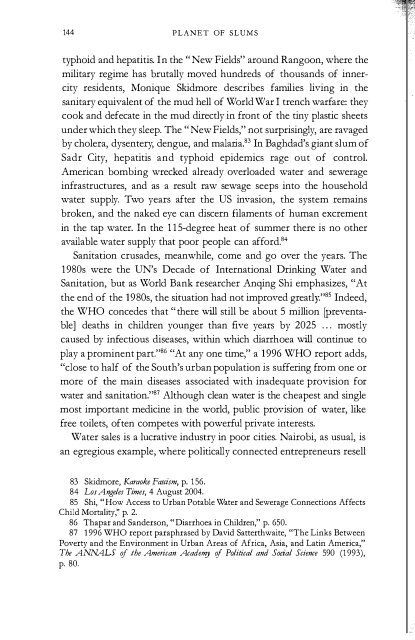Untitled - Rebel Studies Library
Untitled - Rebel Studies Library
Untitled - Rebel Studies Library
Create successful ePaper yourself
Turn your PDF publications into a flip-book with our unique Google optimized e-Paper software.
144 PLANET OF SLUMS<br />
typhoid and hepatitis. In the "New Fields" around Rangoon, where the<br />
military regime has brutally moved hundreds of thousands of innercity<br />
residents, Monique Skidmore describes families living in the<br />
sanitary equivalent of the mud hell of World War I trench warfare: they<br />
cook and defecate in the mud directly in front of the tiny plastic sheets<br />
under which they sleep. The "New Fields," not surprisingly, are ravaged<br />
by cholera, dysentery, dengue, and malaria.83 In Baghdad's giant slum of<br />
Sadr City, hepatitis and typhoid epidemics rage out of control.<br />
American bombing wrecked already overloaded water and sewerage<br />
infrastructures, and as a result raw sewage seeps into the household<br />
water supply. Two years after the US invasion, the system remains<br />
broken, and the naked eye can discern filaments of human excrement<br />
in the tap water. In the lIS-degree heat of summer there is no other<br />
available water supply that poor people can afford.84<br />
Sanitation crusades, meanwhile, come and go over the years. The<br />
1980s were the UN's Decade of International Drinking Water and<br />
Sanitation, but as World Bank researcher Anqing Shi emphasizes, "At<br />
the end of the 1980s, the situation had not improved greatly."8S Indeed,<br />
the WHO concedes that "there will still be about 5 million [preventable]<br />
deaths in children younger than five years by 2025 ... mostly<br />
caused by infectious diseases, within which diarrhoea will continue to<br />
play a prominent part."86 "At any one time," a 1996 WHO report adds,<br />
"close to half of the South's urban population is suffering from one or<br />
more of the main diseases associated with inadequate provision for<br />
water and sanitation."87 Although clean water is the cheapest and single<br />
most important medicine in the world, public provision of water, like<br />
free toilets, often competes with powerful private interests.<br />
Water sales is a lucrative industry in poor cities. Nairobi, as usual, is<br />
an egregious example, where politically connected entrepreneurs resell<br />
83 Skidmore, Karaoke Fascism, p. 156.<br />
84 Los Angeles Times, 4 August 2004.<br />
85 Shi, "How Access to Urban Potable Water and Sewerage Connections Affects<br />
Child Mortality;' p. 2.<br />
86 Thapar and Sanderson, "Diarrhoea in Children," p. 650.<br />
87 1996 WHO report paraphrased by David Satterthwaite, "The Links Between<br />
Poverty and the Environment in Urban Areas of Africa, Asia, and Latin America,"<br />
The ANNALS r the American Academy r Political and Sodal Science 590 (1993),<br />
p. 80.<br />
SLUM ECOLOGY 145<br />
municipal water (which costs very little to famiJies wealthy enough to<br />
afford a tap) in the slums at exorbitant prices. As Mayor Joe Aketch<br />
recently complained, "A study shows that the population of Kibera<br />
slum pays up to five times for a litre of water more than average<br />
American citizens. It is a shame that the rich people of Nairobi can use<br />
their wealth to divert services meant for the poor, to their advantage."88<br />
Unable or unwilling to pay the extortionate price of water from<br />
vendors, some Nairobi residents resort to desperate expedients, including,<br />
two local researchers write, "the use of sewerage water, skipping<br />
bathing and washing, using borehole water and rainwater, and drawing<br />
water from broken pipes."89<br />
The situation in Luanda is even worse: there, the poorest households<br />
are forced to spend 15 percent of their income on water that<br />
private companies simply pump from the nearby, sewage-polluted<br />
Figure 13<br />
Water: The Poor Pay More 9o<br />
Water from vendor versus piped water<br />
(price mark-up in percentage)<br />
%<br />
Faisalabad 6800<br />
Bundun 5000<br />
Manila 4200<br />
Mumbai 4000<br />
Phnom Penh 1800<br />
Hanoi 1300<br />
Karachi 600<br />
Dhaka 500<br />
88 Intermediate Technolo Development Group (ITDG) East Africa Newsletter (August<br />
2002).<br />
89 Mary Arnuyunzu-Nyamongo and Negussie Taffa, "The Triad of Poverty,<br />
Environment and Child Health in Nairobi Informal Settlements," Journal r Health and<br />
Population in Developing Counlties, 8 January 2004, p. 7.<br />
90 Figures from UN Economic and Social Commission for Asia and the Pacific,<br />
1997.


